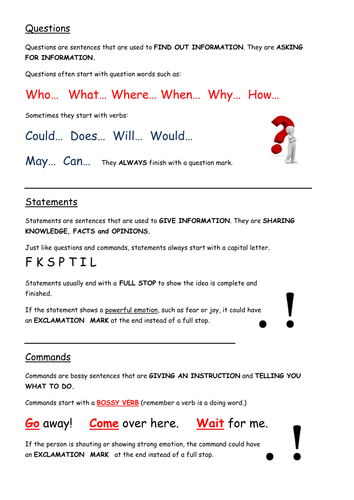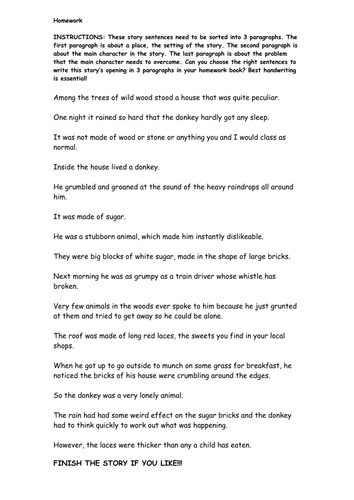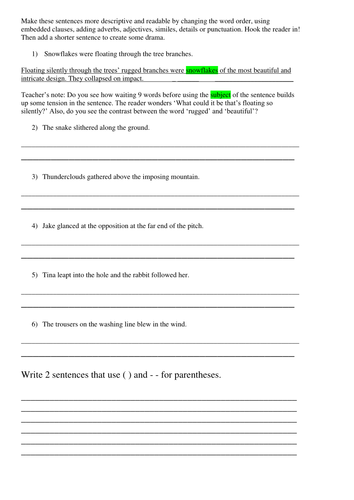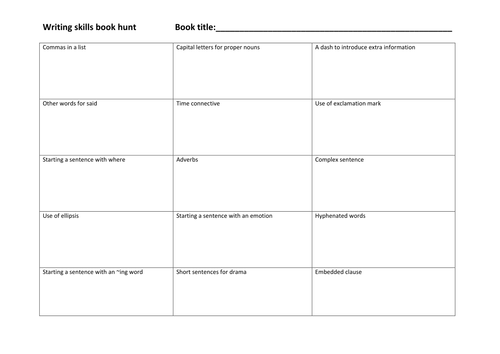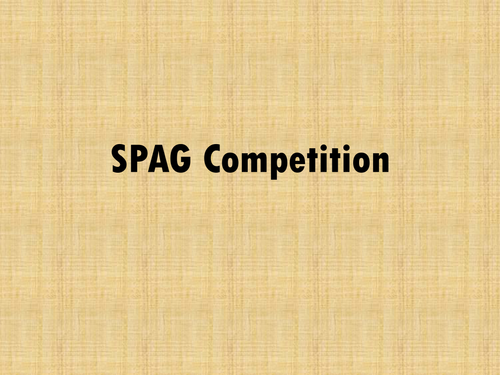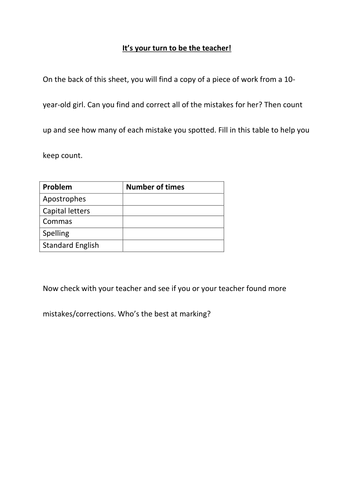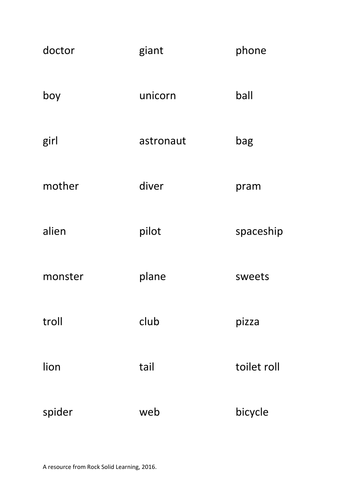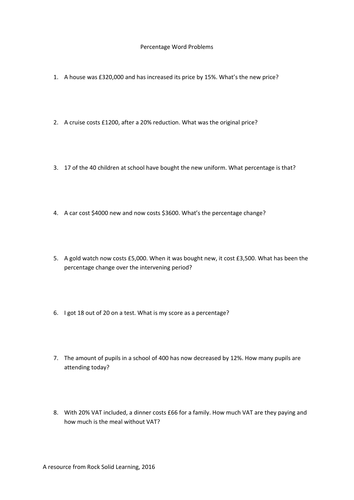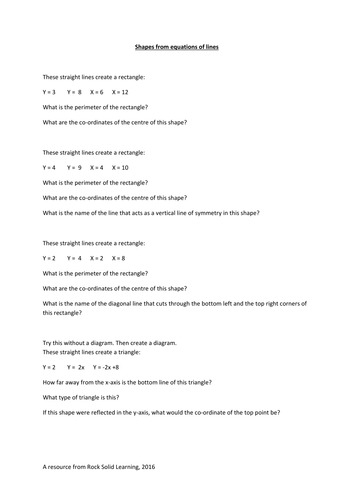46Uploads
41k+Views
16k+Downloads
All resources

Simile matching and writing activity
This resource allows for work on eight sentences of similes, using 'like', 'as' and 'as if'.
It is a cut, match and stick activity.
The first five sentences require the children to match the starts and ends of sentences, with pictures to try and help them see the connections.
The last three sentences have the starts of the sentences and blank boxes for them to create their own endings, with enough room to draw a picture to help show the comparison.
Images have been labelled as appropriate for reuse via the advanced search of Google images.

Sentence types: Statements, Commands, Questions and Exclamations
This double-sided sheet introduces these four sentence types, explaining what they are are what punctuation they need. It looks at statements, commands and questions first before checking understanding with a simple quick identification exercise. It then looks at exclamations (as these are a little harder to explain) and gives another 5 sentences for children to identify whether they are statements or exclamations.

Identifying different phrases (noun phrases, adverbial phrases and prepositional phrases)
The one side of the sheet explains that phrases are unlike clauses in that they have no verbs. It then explains what the three different types of phrases are and gives examples of each.
On the second side of the sheet, there are twelve examples of phases that need to be coloured/highlighted/underlined to show which type of phrase they are. Then there are two sentences that involve all three types of phrases and these too need breaking down into the different phrases.

Paragraphs for upper KS2
There are two activities here, one more tricky than the other.
The first gives about 15 different sentences which all form the opening of a story. The sentences need to be sorted into three paragraphs about setting, character and problem. Even within the paragraphs, they need sorting into a logical order. They are designed in such a way that you could cut them up and move them around until you're happy.
The second activity is a short story that is written as one big chunk of text. This requires the children to mark where the new paragraphs should start. About 5 paragraphs are needed.

Uplevelling writing and word order for more able writers. Colons and Semi-colons.
I used this for homework for more able Year 5 and Year 6 pupils.
The first page is about taking ordinary sentences and making them more interesting by looking at word order for creating tension or excitement, and then following them with shorter sentences for contrast and drama.
The second page looks at the uses of colons and semi-colons, modelling examples before asking the children to write their own.

Writing skills book hunt (skimming and scanning looking for key skills)
In this activity, pupils need a fiction book to hunt for examples of authors using writing skills. Writing skills needed include those such as short sentences for drama, starting sentences in different ways and using different words for 'said'. It also asks them to find examples of ellipsis, exclamation marks, proper nouns, hyphenated words and commas in lists, among other things.
For each of the skills/examples required, there is an example given on the sheet to act as a model and to remind the pupils in case they have forgotten.

Maths competition quiz for KS2 Year 6 SATs revison
This quiz is ideal for two teams of between 4 and 8 but could probably be played with larger groups. It has four rounds including a buzzer round and speed round. There are questions that require team work and some that rely on every member of the team individually. Questions focus mainly on topics that come on the arithmetic paper but also on volume, area and angles.
Enjoy!
Edit: The first version I put online had a couple of simple errors which have now been corrected for future downloads. Apologies to anyone who was using it before I noticed the problem.
Also, I have noticed that it might be worth the teacher printing out the slides if you want the answers before revealing them on the projector (e.g. in the rounds where teams can steal points from each other).

SPAG competition quiz for KS2 Year 6 SATs revision
This quiz is ideal for two teams of between 4 and 8 but could probably be played with larger groups. It has four rounds including a buzzer round and speed round. There are questions that require team work and some that rely on every member of the team individually. Topics focus mainly on word classes, tenses, punctuation, synonyms and antonyms, clauses, phrases and pronouns.
Enjoy!

Editing for punctuation and spelling (marking, checking work, improving work)
In this activity, the pupil is challenged to act as the teacher and mark a piece of work. The text is a well-spaced A4 recount with a number of spelling and punctuation errors, including commas for lists and clauses, capital letters and homophone spelling mistakes. There is an answer sheet too.

Commas for clauses worksheets (subordinate, embedded, relative, brackets)
This resource comprises two differentiated two-sided worksheets. The first looks at identifying main and subordinate clauses, using ~ing words at the start of a subordinate clause, extending sentences with 'which', inserting brackets around clauses as a way of introducing embedded clauses. It also sees whether they can spot/identify relative clauses and relative pronouns.
The second (higher) double-sided worksheet looks at writing sentences with subordinate clauses (using conjunctions, ~ing words and 'which'). On the second side, it gives examples of embedded relative clauses and then asks the pupil to complete more sentences that have already been started.
I used this for homework and revision after the Y5/Y6 pupils had already been taught the main concepts and sentence constructions.

Alan Peat 2a sentences (adjectives, commas for lists)
A lesson to introduce Alan Peat's 2a sentences, presented in a word document so that it can be edited for your needs as required. Pages 1,2,4 can be presented on the IWB screen to the children. These involve the introduction, individual/partner activity using whiteboards and the instructions for the plenary activity (which involves editing and improving a previous piece of the child's English work with this new skill). Page 3 needs to be printed as the worksheet for the main activity (finding 2a sentences in a short story and then writing some of their own 2a sentences with prompts for ideas).

Apostrophes for possession / belonging / possessive
Here we have all of the resources for a lesson on possessive apostrophes that assumes some children will know the basics already. It would be good for the first lesson *you* have taught them on it, assuming they have done it sometime last year, or as a revision lesson after a long break.
It starts with the whole class reading an article and spotting missing apostrophes before focusing in on some whiteboard work using pictures as prompts. A partner work/table group game (which could be made competitive or even silly/funny if you like!) is then followed by some written activities to go in the book. Plenary and homework provided too!

Structuring answers about writers' skills using Point, Evidence, Analysis
This resource comprises two sheets. The first shows a model answer about Sir Arthur Conan Doyle's descriptive writing skills in The Hound of the Baskervilles, beginning with a simple answer, moving to a more detailed answer and finishing with some extra detailed analysis.
The second sheet is made up of prompts for sentence starters on making a point, introducing evidence from the text and beginning to explain what it means.

Making and proving statements using shapes and properties of shapes
The main activity in this lesson begins with asking children to make some true statements about a group of shapes (where the statement will be true for ALL shapes in that group).
From here the activity moves on to looking at a statement about a shape and seeing if children can find an example of a shape which proves this statement and another shape that disproves the statement. A sheet of shapes has been provided so children don't always have to draw shapes but can cut and stick instead.
This resource also comes with 3 introduction or follow up activities linked to shapes and their properties. There are instructions for drawing shapes with given properties; a Carroll diagram for sorting right angles and curved sides, and a table looking for the basic sides and corners of well-known 2D shapes.

Number bonds to 100
Four sheets are provided here: two classwork sheets and two homework sheets with a set for more able and a set for less able.
The sheets look first at making 100 using deines cubes, where children are encouraged to draw the extra cubes and sticks until they reach 100. The second half builds on this, making the link with the deines equipment that the cubes will always make a ten and the sticks will need to add up to the other ninety.
The homework sheets provide more practice of what has been covered in lesson.

Addition and subtraction with negative numbers in the context of temperature
Here we have three resources. The first is a number line from -20 to +20 which will help pupils to complete the two activities.
The first activity asks pupils to increase or decrease a temperature by a given amount of degrees. Blue and red are used to help colour co-ordinate the questions depending on whether the temperature rises or drops. Later questions involve a temperature that first goes up and then comes down a bit, providing a basic two-stage question.
The second activity requires the pupils to do multiple increases or decreases (or both) to get a final temperature. For example: It's 11 degrees and the temperature drops by 2 degrees every night for six nights. It them increases by 3 degrees for one further night. What's the final temperature?

Fractions problem solving
Based on a GCSE exam question, this worksheet has four examples of tables that need filling in. Answers are provided and a helpful hints box at the bottom helps pupils to get started if needed.

Shapes and co-ordinates from equations of lines
This resource provides pupils with equations of lines (e.g. y = 8, y = 4...) that will form a basic shape on a grid. Questions then ask for the perimeter of the shape or the co-ordinates at the centre of the shape. It is good to encourage pupils to find a way of answering these questions without drawing accurate graphs every time but perhaps just little sketches or by looking at the appropriate numbers.
The fourth and final question uses the equations of straight lines to form a triangle with questions asking about the type of triangle and a new co-ordinate if the shape were reflected in the axis.


